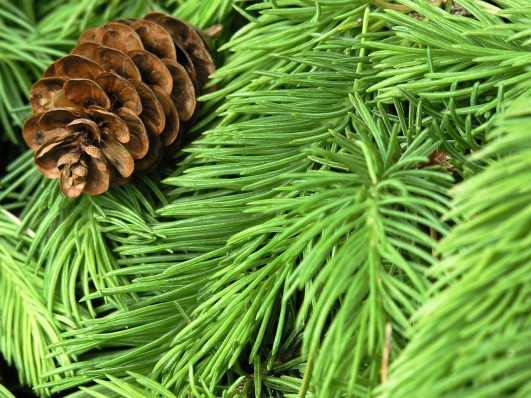The conifers or evergreens were the first real tree form tried here on earth.
The conifers or evergreens were the first real tree form tried here on earth. Their history goes back some 290 million years into the Carboniferous period, which science says was very dry, so the thick tough wax-coated needles that supply their food could have been the result of evolving in those conditions. The conifers or gymnosperms, naked seed plants, have world wide about 550 species in 50 genera. Naked seeds in that they are usually unprotected by an ovule and form unprotected between the scales of the cones. Once the cones mature, the seeds are released to the wind. As with everything in nature there are always exceptions; some pine seeds are released only after being exposed to great heat such as a forest fire.
Most conifers have both male and female flowers on the same tree, but in different structures on different parts of the tree. The male flowers, the pollen sacks, tend to be on the lower parts of the tree and the female flowers that when fertilized become cones tend to be in the upper parts. Though not everyone thinks so, the reproductive structures of conifers, especially the females, are very beautiful in their first stages and are usually reddish to purple in color and resemble tiny pagodas. Larch juvenile female flowers are especially beautiful. I think of them as flowers, unisexual flowers.
If you happen to look up at the top of a spruce tree in about mid June you will see many of these still forming spruce "flowers , whereas below the small brown pollen sacks are also forming in the lower parts of the tree. Conifers in the temperate zone have one growth flush per year, usually from mid June to mid July. This is when the buds break and the new shoots or candles quickly expand to form the current year's growth. Unless you are doing size control, this growing month is a good time to leave the conifers alone.
In the classic conical shape of conifers, the central leader always grows the most and the side branches are programmed to grow to a lesser degree, always maintaining the sharp cone shape. This process is controlled by the growth hormone auxin and cone-shaped conifers are said to be under strong apical control. Many conifers are denizens of our planet's northern reaches and mountainous country where snowfall can be thick and heavy. The sharp conical shape sheds snow readily and it is rare to have snow load damage on a conifer. Until old age they function best with one main central leader; if the tree loses its central leader there will be a quick battle among shoots near the top to see if one can outgrow the others and assume the job of leader.
Many times after losing a leader the tree will develop multiple tops, some of which can be poorly attached to the trunk, and can split off later in storms. On younger trees it is always best to maintain one single strong central leader by pruning off the competition. Choose the strongest, tallest most central leader to remain and prune the others off. As conifers mature or reach a height where they are up in the wind shear the concept of a single leader is surpassed by what I call a flat top, a treetop that isn't gaining much height and starts to spread out and get wider as time goes by. There are some 500-years-plus Douglas firs here in Calgary that are classic examples of this phenomenon.
The "top" is now shaped like an umbrella several feet across and has hundreds of small shoots growing in sync, a method that protects them from getting torn away in all but the fiercest of gusts.
Here in zone 3 there are a handful of conifer genera that do an excellent job of supplying winter interest---firs, larch, spruce, pines, yews, cedars and junipers. Below are descriptions of the best ones to grow here.









